
WATERBIRDS
Scope & Guideline
Connecting Research and Conservation for Waterbird Species
Introduction
Aims and Scopes
- Ecology and Behavior of Waterbirds:
Research articles often explore the ecological roles and behavioral patterns of various waterbird species, providing insights into their feeding, breeding, and migratory behaviors. - Conservation and Habitat Management:
The journal emphasizes conservation strategies and habitat management practices, showcasing studies that assess the impacts of environmental changes and human activities on waterbird populations. - Monitoring and Population Dynamics:
A significant focus is placed on monitoring waterbird populations, using both traditional and innovative methodologies to track changes over time and assess population health. - Impact of Climate Change:
The effects of climate change on waterbirds are a recurring theme, with studies investigating how shifting climates influence distribution, breeding success, and habitat availability. - Methodological Innovations in Waterbird Research:
The journal highlights novel research methods, including technology-assisted monitoring and citizen science approaches, which enhance data collection and analysis in waterbird studies.
Trending and Emerging
- Climate Change and Its Effects:
There is an increasing focus on the impacts of climate change on waterbird populations, including studies on habitat shifts, breeding success, and distribution changes due to altered environmental conditions. - Innovative Monitoring Techniques:
Recent publications highlight advancements in monitoring techniques, such as satellite tracking and eDNA analysis, which enhance understanding of waterbird movements and habitats. - Citizen Science and Community Engagement:
The journal is increasingly featuring studies that leverage citizen science, emphasizing the role of community involvement in waterbird conservation and monitoring efforts. - Interdisciplinary Approaches:
Emerging themes reflect interdisciplinary research that integrates ecology, conservation biology, and social sciences to address complex challenges facing waterbirds. - Invasive Species and Ecosystem Interactions:
Research examining the effects of invasive species on waterbird habitats and populations is gaining prominence, recognizing the interconnectedness of ecosystems.
Declining or Waning
- Traditional Nesting Studies:
Research focusing solely on traditional nesting behaviors and metrics has seen a decline, as more emphasis is placed on understanding broader ecological impacts and conservation needs. - Historical Comparisons without Modern Context:
Studies that compare historical data without integrating modern ecological contexts or threats have decreased, reflecting a shift towards more relevant and actionable research. - Generalized Species Accounts:
There is a noticeable reduction in generalized accounts of waterbird species, as the journal increasingly favors targeted studies that address specific challenges or conservation strategies. - Localized Studies without Broader Implications:
Research that focuses narrowly on localized populations without discussing broader implications for conservation or ecological understanding is becoming less prevalent. - Repetitive Methodologies:
The use of repetitive or outdated methodologies that do not incorporate new technologies or approaches is waning, as the field moves towards more innovative and effective research techniques.
Similar Journals
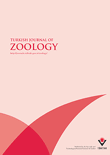
TURKISH JOURNAL OF ZOOLOGY
Connecting Scholars through Animal Science InsightsThe TURKISH JOURNAL OF ZOOLOGY, published by the esteemed Tubitak Scientific & Technological Research Council Turkey, serves as a pivotal platform for the dissemination of research in the field of zoology and animal science. With an ISSN of 1300-0179 and an E-ISSN of 1303-6114, this journal has been contributing to the scientific community since its inception in 1994 and will continue to do so through 2024. Renowned for its scientific rigor, the journal holds a Q3 ranking in the 2023 category of Animal Science and Zoology, placing it within the prominent ranks of Scopus with a current percentile of 56, and an overall rank of 214 out of 490 in its domain. As an essential resource for researchers, professionals, and students, the journal prioritizes quality research, fostering knowledge exchange and collaboration among scholars worldwide. With its commitment to advancing understanding in zoological sciences, the TURKISH JOURNAL OF ZOOLOGY stands as a significant contribution to the global scientific dialogue.
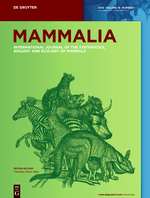
MAMMALIA
Innovating insights into animal science and behavior.MAMMALIA, published by Walter de Gruyter GmbH, is a renowned academic journal founded in 1936 that serves as a pivotal resource for researchers and professionals in the fields of Animal Science and Zoology as well as Ecology, Evolution, Behavior and Systematics. With an ISSN of 0025-1461 and an E-ISSN of 1864-1547, this journal has made significant contributions to mammalian research over the decades and continues to be pivotal in advancing knowledge within the scientific community. MAMMALIA is indexed in prominent databases, boasting a current Scopus ranking that places it within the upper echelons of the Q2 category in Animal Science and Zoology, and Q3 in Ecology, Evolution, Behavior and Systematics. Although it does not offer open access, the journal remains accessible through various academic institutions, ensuring that valuable research findings are disseminated widely. The journal’s commitment to quality and excellence in the study of mammals aligns with its high impact within the field, engaging a diverse readership that includes researchers, students, and professionals dedicated to furthering the understanding of mammalian biology. For more information, visit their office located at Genthiner Strasse 13, D-10785 Berlin, Germany.
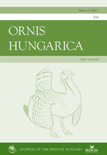
ORNIS HUNGARICA
Fostering collaboration through open access research.ORNIS HUNGARICA, an esteemed journal in the fields of Animal Science and Zoology as well as Ecology, Evolution, Behavior and Systematics, is published by Walter de Gruyter GmbH, a leading scientific publisher renowned for its commitment to disseminating high-quality research. Operating under an Open Access model since 2012, this journal provides invaluable access to scholarly articles, fostering collaboration and knowledge sharing among researchers and professionals. With its ISSN 1215-1610 and E-ISSN 2061-9588, ORNIS HUNGARICA has become a noteworthy platform for innovative studies and findings from Hungary and beyond, contributing significantly to the discourse in its field. As indicated by its Q3 ranking in Animal Science and Zoology and Q4 ranking in Ecology, the journal is recognized for its diverse research contributions, although it aims to expand its reach and relevance in future editions. Researchers and students alike will find in ORNIS HUNGARICA a dedicated resource for advancing knowledge and furthering the understanding of avian biology and ecology.

JOURNAL OF AVIAN BIOLOGY
Championing the study of birds to inspire conservation efforts.Journal of Avian Biology, published by Wiley, is a leading journal in the field of animal science and zoology, with an impressive impact factor highlighting its significance in advancing our understanding of avian ecology and behavior. Since its inception in 1994, this journal has provided a vital platform for researchers, professionals, and students to share innovative studies and findings related to avian biology, contributing to a broader understanding of ecological dynamics and conservation strategies. Recognized in the Q1 category for Animal Science and Zoology and Q2 for Ecology, Evolution, Behavior and Systematics, it ranks 112th out of 490 in its primary field, demonstrating a strong percentile performance. The journal invites submissions that explore diverse aspects of avian research, fostering interdisciplinary discussions that are crucial for ongoing scientific inquiries. With both print and electronic formats, it maintains an accessible repository of knowledge for the global conservation community. Engage with the latest in avian studies through the Journal of Avian Biology and contribute to the evolution of this critical field.

MARINE ORNITHOLOGY
Advancing Knowledge on Oceanic Birds and Their EcosystemsMarine Ornithology, published by the Pacific Seabird Group, is a vital resource in the field of animal science, zoology, and oceanography. With an ISSN of 1018-3337 and E-ISSN of 2074-1235, this journal has been a cornerstone for researchers and enthusiasts since its inception, actively contributing to the understanding of marine bird species and their ecosystems. Although it is currently not an open-access journal, it provides critical insights and findings that inform both academic research and practical conservation efforts. With its category quartiles positioned in Q3 for both Animal Science and Zoology, and Oceanography, Marine Ornithology occupies a significant, albeit competitive niche among scholarly publications. Researchers can benefit from its comprehensive coverage of marine avian studies, which is crucial for addressing the challenges these species face in changing oceanic environments. As the journal continues to evolve, with coverage from 1990 to 2024, it maintains an essential role in enriching our knowledge of marine biodiversity.

BIRD CONSERVATION INTERNATIONAL
Exploring vital ecological interactions that sustain bird populations.BIRD CONSERVATION INTERNATIONAL, published by Cambridge University Press, stands as a premier academic journal dedicated to the field of avian conservation and the vital ecological interactions that sustain bird populations worldwide. With an impressive impact factor reflected through its Q1 ranking in Animal Science and Zoology, alongside notable Q2 standings in Ecology and Nature and Landscape Conservation, this journal provides a crucial platform for researchers and practitioners committed to advancing the science and practice of bird conservation. Spanning articles from its inception in 1991 through to its future publications in 2024, BIRD CONSERVATION INTERNATIONAL not only fosters innovative research but also nurtures a global community dedicated to the preservation of avian species and their habitats. While currently not offering open access, it remains a cornerstone for scholarly communication in its field, making significant contributions to knowledge and policy shaping conservation efforts across the globe.

ORNIS FENNICA
Unveiling the Secrets of Avian Behavior and ConservationORNIS FENNICA, published by BirdLife Finland, is a seminal journal dedicated to the field of ornithology and avian ecology. Established in Finland, this journal has been a vital resource for researchers, professionals, and students since its inception, evolving through converged publication periods from 1979 to 1985 and again from 1991 to the present. ORNIS FENNICA holds a Q2 category ranking in Animal Science and Zoology for 2023, indicating its significant influence and reputation within the academic community, as reflected in its Scopus ranking of 242 out of 490 in its field. The journal aims to promote the study of birds, encompassing aspects such as behavior, conservation, and biodiversity, thus serving as a crucial platform for disseminating innovative research findings. Although it is not open access, ORNIS FENNICA remains committed to advancing ornithological knowledge and supporting the scientific community's efforts to understand and protect avian species. For those invested in the nuances of bird research, this journal offers an invaluable repository of scholarly articles, reviews, and insights.

NOTORNIS
Illuminating the path of avian research and conservation.NOTORNIS is a prestigious academic journal published by the Ornithological Society of New Zealand, dedicated to advancing the field of ornithology and contributing meaningful research related to avian species. With ISSN 0029-4470 and E-ISSN 1177-7680, this journal has been a vital resource for scholars since its inception in 1982, continuously fostering discourse within the scientific community, particularly in the realms of animal science and zoology. Though it currently holds a quartile ranking of Q4, with a Scopus rank of #250 out of 490 in its category, NOTORNIS occupies a unique niche in ornithological research, promoting studies that highlight the ecological and biological intricacies of birds. This journal is critical not only to researchers and professionals in zoology but also to students and educators aiming to engage with contemporary avian research. As New Zealand's leading ornithological publication, NOTORNIS underscores the importance of avifaunal studies in conserving biodiversity and understanding ecological dynamics.
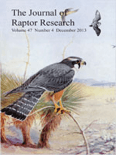
JOURNAL OF RAPTOR RESEARCH
Illuminating the Path for Raptor PreservationJOURNAL OF RAPTOR RESEARCH, published by Raptor Research Foundation Inc, serves as a pivotal platform for disseminating research related to the biology and conservation of raptors. Established in 1990, this esteemed journal has consistently contributed to the field of Animal Science and Zoology, securing a Q2 ranking in the 2023 category quartiles on Scopus, which highlights its significant impact and relevance. With an ISSN of 0892-1016 and an E-ISSN of 2162-4569, the journal presents an extensive range of studies aimed at promoting the understanding and preservation of these majestic birds of prey. Researchers, conservationists, and students alike will find invaluable insights and peer-reviewed articles that address current conservation challenges, ecological dynamics, and the latest methodological advancements in the study of raptors. Although not open access, the journal is integral for anyone dedicated to advancing the knowledge and appreciation of avian species in ecological and conservation contexts.
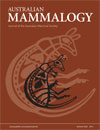
AUSTRALIAN MAMMALOGY
Championing Insights into Australia’s Diverse Mammal SpeciesAustralian Mammalogy, published by CSIRO PUBLISHING, is a pivotal journal in the fields of Animal Science and Zoology as well as Ecology, Evolution, Behavior and Systematics. With its ISSN 0310-0049 and E-ISSN 1836-7402, this esteemed journal has been instrumental in disseminating critical research findings since 2000, and continues to evolve up to 2024. Ranked in the Q2 quartile of both its categories for 2023, it showcases a diverse array of studies that contribute to understanding Australia’s unique mammalian fauna and its ecological dynamics. Researchers, professionals, and students will find valuable insights in its peer-reviewed articles, which are essential for advancing knowledge in these essential scientific disciplines. Located in Australia at UNIPARK, Locked Bag 10, Clayton, VIC, this journal remains committed to fostering scholarly communication within the global scientific community.